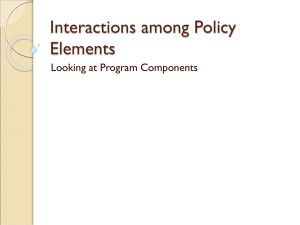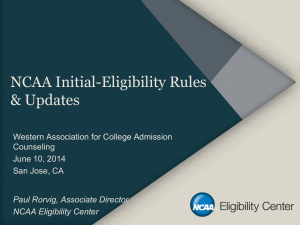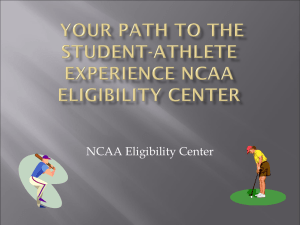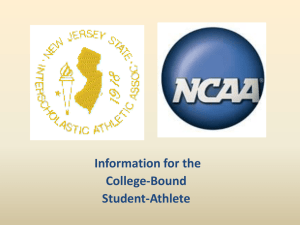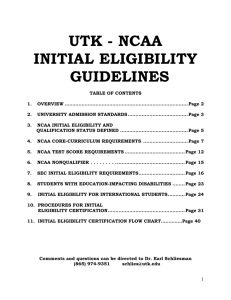INITIAL ELIGIBILITY: NCAA ELIGIBILITY CENTER REQUIREMENTS
advertisement
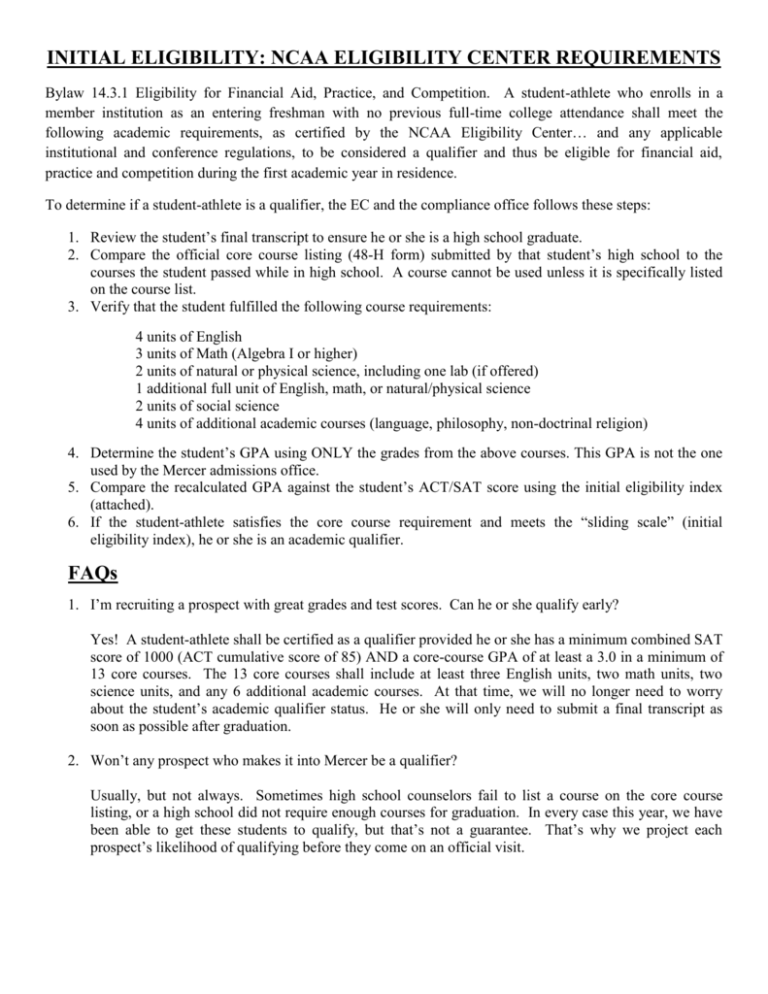
INITIAL ELIGIBILITY: NCAA ELIGIBILITY CENTER REQUIREMENTS Bylaw 14.3.1 Eligibility for Financial Aid, Practice, and Competition. A student-athlete who enrolls in a member institution as an entering freshman with no previous full-time college attendance shall meet the following academic requirements, as certified by the NCAA Eligibility Center… and any applicable institutional and conference regulations, to be considered a qualifier and thus be eligible for financial aid, practice and competition during the first academic year in residence. To determine if a student-athlete is a qualifier, the EC and the compliance office follows these steps: 1. Review the student’s final transcript to ensure he or she is a high school graduate. 2. Compare the official core course listing (48-H form) submitted by that student’s high school to the courses the student passed while in high school. A course cannot be used unless it is specifically listed on the course list. 3. Verify that the student fulfilled the following course requirements: 4 units of English 3 units of Math (Algebra I or higher) 2 units of natural or physical science, including one lab (if offered) 1 additional full unit of English, math, or natural/physical science 2 units of social science 4 units of additional academic courses (language, philosophy, non-doctrinal religion) 4. Determine the student’s GPA using ONLY the grades from the above courses. This GPA is not the one used by the Mercer admissions office. 5. Compare the recalculated GPA against the student’s ACT/SAT score using the initial eligibility index (attached). 6. If the student-athlete satisfies the core course requirement and meets the “sliding scale” (initial eligibility index), he or she is an academic qualifier. FAQs 1. I’m recruiting a prospect with great grades and test scores. Can he or she qualify early? Yes! A student-athlete shall be certified as a qualifier provided he or she has a minimum combined SAT score of 1000 (ACT cumulative score of 85) AND a core-course GPA of at least a 3.0 in a minimum of 13 core courses. The 13 core courses shall include at least three English units, two math units, two science units, and any 6 additional academic courses. At that time, we will no longer need to worry about the student’s academic qualifier status. He or she will only need to submit a final transcript as soon as possible after graduation. 2. Won’t any prospect who makes it into Mercer be a qualifier? Usually, but not always. Sometimes high school counselors fail to list a course on the core course listing, or a high school did not require enough courses for graduation. In every case this year, we have been able to get these students to qualify, but that’s not a guarantee. That’s why we project each prospect’s likelihood of qualifying before they come on an official visit. 3. What if a prospect is missing a course or two? In some cases, a student may qualify for a waiver. Some waivers are “obvious automatic” (meaning they can be granted without paperwork), although most require a formal waiver process. These are most successful where a student has clear academic merit, but is missing only one or two units. 4. What if a prospect is close, but slightly off, the sliding scale? In some cases, a student may qualify for a waiver. There is precedent that in extraordinary circumstances (natural disasters, death in the family, severe health issues, etc.) the EC may certify students who do not meet the sliding scale. 5. What if a prospect attends multiple high schools? The EC will consider courses taken at all high schools the student attended. Even if the student attended a school for a very brief period of time, the EC requires a transcript from that school. 6. What if a prospect takes non-traditional courses? If a student takes non-traditional courses, they must be approved by the EC. Courses taught via the Internet, distance learning, independent study, individualized instruction, correspondence, and courses taught by similar means may be used to satisfy NCAA core-course requirements if all of the following conditions are satisfied: The course meets all requirements for a core course: o The course must be a recognized academic course and qualify for high school graduation credit in one or a combination of the following areas: English, math, natural/physical science, social science, foreign language, non-doctrinal religion, or philosophy o A course must be considered “college preparatory” by the high school. o A math course must be at the level of Algebra I or higher o A course must be taught by a qualified instructor as defined by the appropriate academic authority o A course must be taught at or above the high school’s regular academic level (i.e. not remedial) The instructor and the student have ongoing access to one another for purposes of teaching, evaluating and providing assistance to the student throughout the duration of the course The instructor and the student have regular interaction with one another for purposes of teaching, evaluating and providing assistance to the student throughout the duration of the course The student’s work (e.g. exams, papers, assignments) is available for evaluation and validation Evaluation of the student’s work is conducted by the appropriate academic authorities in accordance with the high school’s established academic policies The course includes a defined time period for completion; AND The course is acceptable for any student and is placed on the high school transcript 7. What if a prospect was jointly enrolled at a local college? College courses may be used to satisfy core-curriculum requirements if accepted by the high school, provided the courses are accepted for any other student, meet all other requirements for core courses and are placed on the student’s high school transcript. 8. How do we send in documents to the EC? Unofficial documents, such as letters, may be sent via fax. Official documents, such as transcripts, must be sent by mail. If a document is time sensitive, please send via UPS or Fed Ex in order to receive a tracking number. Parents and prospects can call the EC at 877-262-1492. The general fax line is 317968-5100. The overnight/express mail delivery address is: NCAA Eligibility Center Certification Processing 1802 Alonzo Watford Sr. Drive Indianapolis, IN 46202 9. What if a prospect has a diagnosed learning disability? All standards apply to students regardless of a learning disability. However, high school courses for students with education-impacting disabilities may be used to fulfill the core-curriculum requirements, even if such courses appear to be taught at a level below the regular academic instructional level (e.g. special education) if the high school principal submits a written statement to the EC indicating that the course is substantially comparable, quantitatively and qualitatively, to similar core courses offerings in that academic discipline and the courses appear on the high school’s list of approved core courses. Students with education-impacting disabilities still must complete the required core courses and achieve the minimum GPA. The only time education-impacting disability documentation needs to be sent to the EC is if a student would like to use core courses taken after high school graduation to satisfy initial eligibility requirements. At that time, the student must submit the following documents: A signed Buckley Statement (with an parent/guardian listed who can speak to the student’s disability) EID Cover Sheet Signed copy of the most recent professional evaluation report diagnosing the student’s education-impacting disability, including the diagnostic test results (must be within three years) A copy of the student’s most recent IEP, Section 504 Plan, Summary of Performance, or (for private schools) statement on the high school’s letterhead describing the accommodations received by the student due to the disability (must be within three years) The student’s NCAA ID number, high school graduation year, permanent address, and phone number 10. Is there a time limitation to complete core course requirements? Yes. A prospect must complete his or her core requirements not later than the high school graduation date of his or her 9th grade (or equivalent) class. However, if a prospect graduates from high school within the core time limitation, he or she may use one core course completed during the summer immediately after high school to satisfy initial eligibility requirements. If a student with a diagnosed education-impacting disability graduates from high school within the core time limitation, he or she may use up to three courses completed after high school to meet initial academic eligibility standards. The student may complete those courses at an institution other than his or her high school, although the student may not use the courses if the student received institutional financial aid while completing the courses. 11. How does the EC recalculate the student’s GPA? The EC first reviews the student’s transcript to determine which of the student’s courses are listed on the school 48-H form. The EC then takes the top grades the student earned in approved courses listed in each of the required academic areas. Using the high school’s own grading scale, the EC assigns each “A” a 4, each “B” a 3, and so on. If a high school uses “plus” or “minus” grades in its scale, no credit is given or taken away for a “plus” or “minus.” A high school’s normal practice of weighting honors or advanced courses may be used to compute the quality points awarded in those courses, provided a written statement verifying the grading policy accompanies the official transcript. After assigning each course a grade point, the EC then divides the total number by the number of courses (usually 16). That number is the GPA used in the initial eligibility index (“sliding scale”). 12. How does the EC recalculate the student’s test score? For SAT scores, the EC combines the student’s scores in critical reading and math. For example, if a student earned a 440 in the verbal section and 560 in the math section, he or she has a 1000 SAT. For ACT scores, the EC combines the scores the student earned in each section. For example, if the student earned an 18, 20, 25 and a 26, his or her score is a 89. This is the test score used in the initial eligibility index. 13. What about international students? The EC employs experts who are very familiar with the educational systems of other parts of the world. Deference is given to the educational system of the student’s home country. Therefore, graduation from secondary school is based on the student’s prescribed educational path in his or her country. However, should a student elect a path involving further secondary school education and not complete that program, there may be eligibility ramifications. Alert the compliance office as soon as possible about an incoming international student-athlete. 14. Do ESL (English as a Second Language) courses count? It is permissible to use an advanced-level ESL course to satisfy core-curriculum requirements, provided it is reviewed through the NCAA Initial Eligibility Center Waiver process. Other ESL courses taught in disciplines other than English (social sciences, etc.) may satisfy a core-course requirement, provided they are qualitatively and quantitatively the same as the comparison course in the regular course offering. 15. Can a prospect qualify early if he or she wants to enroll early? A waiver may be granted by the Initial Eligibility Waiver Committee for a student who left high school after competition of the junior year or during the senior year to enter college under an early admission program. The program must be open to students solely on the basis of outstanding academic performance and promise, and the following conditions must be met: o For the last four completed semesters of high school, the student must have maintained a cumulative GPA of at least a 3.5 and be ranked in the top 20% of his or her high school class, o The student has not met the requirements for high school graduation AND o Any remaining course deficiency must be in English (one unit)
